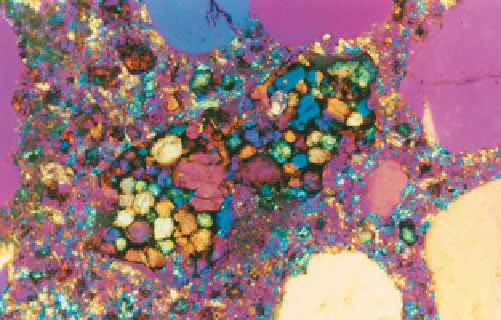Geoscience Reference
In-Depth Information
of cement are given in Bye (1999), Taylor (1997), and
Barnes and Bensted (2002). When studying cement
reactions it is important to know that a shorthand system
called 'cement chemists' notation' is used describe
cement compounds. This uses single letters to abbreviate
the usual oxide formulae as shown in
Table 20
.
The hydrated cement paste within concrete contains
residual grains of unhydrated/partially hydrated clinker
and these can be examined microscopically to determine
the cement type. In modern cements, residual cement
grains are chiefly small (<20 μm) with sporadic medium-
sized (20-60 μm) and rare large grains (60-100 μm)
sometimes present. In older concrete (pre-1950s),
Portland cement was more coarsely ground and very
large relict cement grains (>100 μm) are commonly
observed. Figures
162-164
show the appearance in thin
section of a large residual unhydrated cement grain in
ordinary Portland cement concrete. The cement grain has
an appearance reminiscent of a bunch of grapes,
consisting of agglomerated phenocrysts of calcium
Table 20
Cement chemists' notation.
Oxide
CaO
SiO
2
Al
2
O
3
Fe
2
O
3
H
2
O
a
2
O
2
OS
MgO
CO
2
3
Symbol
C
S
A
F
H
N
K
S
M
C
162
163
162-164
Modern residual Portland cement grain in
thin section specimen viewed in PPT (
162
), XPT (
163
),
and in XPT with the gypsum plate inserted into the
light path (
164
). The cement grain is surrounded by
uncarbonated cement matrix and quartz fine
aggregate particles (white in PPT); ×150.
164





